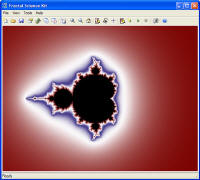
Fractal Window Overview
The Fractal Science Kit fractal generator Fractal Window is the window that displays a fractal image.
The fractal image is defined by a set of fractal properties found on the Properties Pages accessed using the Properties Window. When you start the Fractal Science Kit (or open a new Fractal Window), a default fractal is displayed. You can control the set of default property values by creating a fractal properties file named My Default Fractal.xml in the Fractal Science Kit Home folder. See the Save Fractal Properties command description for details on saving the fractal properties to a file. My Default Fractal.xml also controls the initial Fractal Window displayed when you start the Fractal Science Kit.
The Fractal Window has menu and toolbar controls that provide access to all the other windows supported by the application. You can open additional Fractal Windows so that you can work with multiple fractals concurrently. There is no distinction between the 1st Fractal Window and any of the others that you have opened. You can close the 1st Fractal Window, and if additional Fractal Windows are open, the application will not exit. When the last Fractal Window is closed, the application will exit and any remaining open windows are closed automatically. You can exit the application at once using the Exit item on the File menu on any Fractal Window and all open Fractal Windows will immediately close.
If you open a fractal properties file (see Open File below), the name of the file is displayed in the window's banner. Otherwise, the window's banner displays a default name generated by the application. When you save a fractal properties file (see Save Fractal Properties below), you can change the name if required. The other windows associated with this Fractal Window (Properties Window, Data Information Window, Information Window) will also display the same name in their banner. If you save the fractal image (see Save Fractal Image below), the name is also used as the default image name.
When you click on the fractal image, information with respect to the sample point on which you clicked is displayed in the Information Window. Click on Information Window on the View menu to view this information. This information is very useful when you are setting up the Color Controllers for a fractal in that you can click on different parts of the fractal and examine the data associated with the different points to guide your decisions with respect to mapping the data to color. For example, an orbit trap may assign different index values to different parts of the trap and you can use this to map different colors to the different parts. By clicking on the trap you can examine which parts have which index values to assist in the index to color mapping.
Depending on the state of several items on the Tools menu, a click on the Fractal Window may have other effects in addition to displaying information about the point in the Information Window. The state (checked/unchecked) of the Preview Julia, Show Orbit, and Copy Point to Clipboard items on the Tools menu control these effects. See the discussion of the Tools menu below for details.
If none of the above mentioned items on the Tools menu are selected (checked), you can double-click on a point in the Fractal Window to perform a 2x zoom, centered on the point. For a much more controlled zoom, see the discussion of the Zoom In item on the View menu below.
The menu items provide complete access to all of the commands. Most of the commands have a toolbar button as well. The following description is aimed at the menu items but applies equally well to the toolbar buttons which are not described separately. Hold the mouse over the toolbar button to see the associated menu item text.
File Menu
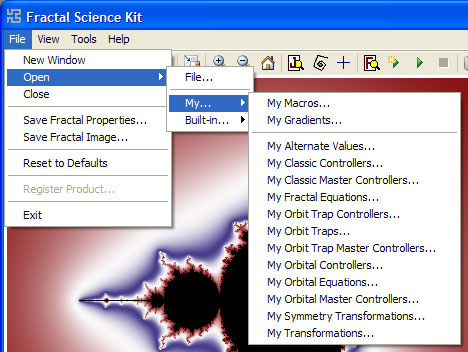
The File menu has commands to:
-
Open a New Window. The new Fractal Window has all the default property settings. If you want to open a new window that is a copy of an existing window, use the Display Fractal in New Window menu item on the Tools menu of the window you want to copy. You can control the set of default property values by creating a fractal properties file named My Default Fractal.xml in the Fractal Science Kit Home folder. See the Save Fractal Properties command description for details on saving the fractal properties to a file. My Default Fractal.xml also controls the initial Fractal Window displayed when you start the Fractal Science Kit.
-
Open a File. The Open File dialog is displayed so you can choose a file. All files created by the Fractal Science Kit are saved as XML files. On the Open File dialog, navigate to, and select the XML file, and click Open. If the file contains a set of programs, macros, or gradients; a browser (Program Browser, Macro Editor, Gradient Browser) is opened to view/edit the file. If the file contains fractal properties, you are asked if you want to replace the properties in the existing window or open a new window. If you choose to replace the properties in the existing window, the properties are replaced but the fractal is not redisplayed. This allows you to make additional changes to the properties before you display the fractal. If you do not need to make any changes, simply click Display Fractal on the Tools menu to display the fractal. If you choose to open a new window, the new window is created and the fractal is displayed.
The File... command can also open selected gradient files created by other fractal programs (i.e., files named *.ugr). When the Open File dialog is displayed, navigate to, and select the gradient file, and click Open. The gradients in the file are converted to a form compatible with the Fractal Science Kit and opened in a read-only Gradient Browser where you can copy selected gradients to your set of saved gradients in My Gradients where they will be accessible to your programs. -
Open a browser (Program Browser, Macro Editor, Gradient Browser) to view/edit the set of My... programs/macros/gradients. These sets of objects are hooked into the application just like the built-in objects. The browser is used to maintain these sets. The browser allows you to order the objects in your set, add or delete objects from the set, rename an object, edit the object data, and/or export objects to a file.
-
Open a browser (Program Browser, Macro Editor, Gradient Browser) to view the set of Built-in... programs/macros/gradients. The built-in objects cannot be changed but you can copy/paste them into your set of objects and modify them there. You can also reference a built-in object in any fractal and the object is copied into the fractal and can be modified there.
-
Close this Fractal Window and any windows associated with this Fractal Window.
-
Save Fractal Properties... displays the Save Fractal Properties dialog so you can name a file. Fractals are saved as XML files. This command saves the properties for this Fractal Window to the named XML file.
-
Save Fractal Image... displays the Save Image dialog so you can name a file. Image files can be saved as BMP, JPEG, TIFF, or PNG files. This command saves the current fractal image to the named file.
-
Reset to Defaults resets the fractal properties to the default property settings.
-
Register Product... displays the Register Product Dialog so you can register the product. Once the product is registered, this item is disabled.
-
Exit the application. All other windows are automatically closed.
View Menu
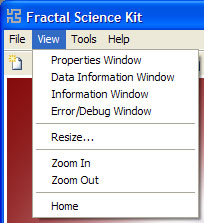
The View menu has commands to:
-
View the properties for this fractal in the Properties Window. There is a separate Properties Window for each fractal.
-
View information related to the data for this fractal in the Data Information Window. There is a separate Data Information Window for each fractal.
-
View information related to this fractal in the Information Window. There is a separate Information Window for each fractal.
-
View diagnostics in the Error/Debug Window. There is a single Error/Debug Window shared by all fractals.
-
Resize... displays the Set Image Viewport dialog to adjust the size/position/angle of the viewable area of the complex plane and/or the size (in pixels) of the fractal image. The Center, Magnification, and Angle, are the point on the complex plane mapped to the center of the window, the amount of magnification applied to the image, and the angle of rotation about the center point, respectively. The Image Width and Image Height specify the image width/height in pixels and can be no more than 8000. Check Check to constrain aspect ratio to retain the current ratio of Image Width to Image Height; i.e., if you change width/height, automatically change height/width to keep same aspect ratio. Note that I update text of the other field when you hit Enter or move to a different field. When adjusting the Image Width and Image Height, remember that larger images require more memory and take longer to generate. If Anti-Aliasing is turned on, these requirements are amplified and you can easily consume all the memory on your computer. To generate larger images, see Generating Large Images. The size/position/angle controls are disabled for L-System fractals.
-
Display the Zoom In box to allow you to magnify an area of the fractal. The zoom box is displayed on the image and represents the portion of the image that will fill the window after the zoom operation is complete. You can resize the zoom box by selecting 1 of the 8 resize handles and dragging it to a new location. The resize handle opposite the one you select/drag, remains fixed at its current position, and the zoom box is resized as you move the selected handle. The aspect ratio of the zoom box is the same as the image and cannot be changed; i.e., the ratio of the zoom box height to the zoom box width will always match that of the image. If you hold down the SHIFT key while dragging the resize handle, the center of the zoom box remains fixed as you resize the zoom box. You can move the zoom box by depressing the mouse button inside the zoom box and dragging the zoom box to a new location. You can rotate the zoom box by depressing the mouse button on part of the image outside the zoom box and dragging the mouse to rotate the zoom box about its center. Once you have positioned the zoom box to the desired location, use one of the items on the Tools menu (or the associated toolbar buttons) to display the fractal with its new magnification/orientation. Alternatively, you can double-click on the fractal image while the zoom box is displayed to invoke the Display Fractal command. If you wish to cancel the zoom operation, simply select the menu item or toolbar button again to remove the zoom box. While the zoom box is displayed, the Zoom In menu item has a check next to it and the Zoom In toolbar button is depressed. The Zoom In menu item and toolbar button are disabled on L-System fractals. To display grid lines on the zoom box, check the Zoom Box Grid option on the General tab of the Options Dialog.
-
Display the Zoom Out box to allow you to expand the view to see parts of the fractal outside the current view. The zoom box is displayed on the image and represents the portion of the window that will contain the current image after the zoom operation is complete. This not as natural as the Zoom In operation and takes a little getting used to, but is very flexible. The mechanics of resizing, moving, and rotating the zoom box, are the same as when zooming in. Once you have positioned the zoom box to the desired location, use one of the items on the Tools menu (or the associated toolbar buttons) to display the fractal with its new magnification/orientation. Alternatively, you can double-click on the fractal image while the zoom box is displayed to invoke the Display Fractal command. If you wish to cancel the zoom operation, simply select the menu item or toolbar button again to remove the zoom box. While the zoom box is displayed, the Zoom Out menu item has a check next to it and the Zoom Out toolbar button is depressed. The Zoom Out menu item and toolbar button are disabled on L-System fractals. To display grid lines on the zoom box, check the Zoom Box Grid option on the General tab of the Options Dialog.
-
Reset the view to the Home area; i.e., set the Magnification to 1, move the Center of the view to (0,0), set the Angle of rotation to 0, and redisplay the fractal. The Home menu item and toolbar button are disabled on L-System fractals.
Tools Menu
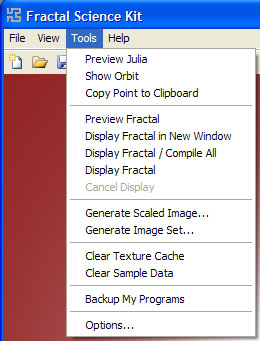
The Tools menu has the following commands:
-
Preview Julia changes the cursor to a cross and places the Fractal Window into a state where clicking on the Mandelbrot fractal generates a Julia fractal preview in the Preview Window. The point on the Mandelbrot fractal where you click is used as the Julia Constant for the preview. There is a single Preview Window shared by all windows and each click on the Mandelbrot image generates a new Julia fractal preview, replacing any image currently in the Preview Window. If you wish to cancel the operation, simply select the menu item or toolbar button again. While you are in this state, the Preview Julia menu item has a check next to it and the Preview Julia toolbar button is depressed. The Preview Julia menu item and toolbar button are disabled on Julia fractals, Orbital fractals, and L-System fractals. The preview is based on the properties that were in effect when the Mandelbrot fractal was generated. Any changes to the properties pages since the Mandelbrot fractal was generated have no affect on the resulting Julia fractal. See Exploring Julia Fractals for details.
-
Show Orbit changes the cursor to a cross and places the Fractal Window into a state where clicking on the fractal image displays the orbit associated with that point as a series of dashed lines connecting the orbit points. Each click on the fractal image generates a new orbit display, replacing any orbit currently displayed. In addition to displaying the orbit, information about the final orbit point is displayed in the Information Window. If you wish to cancel the operation, simply select the menu item or toolbar button again. While you are in this state, the Show Orbit menu item has a check next to it and the Show Orbit toolbar button is depressed. The Show Orbit feature works best when you are zoomed out to the point where the entire fractal is visible. If you are zoomed in too far, orbit points may be omitted and the orbit display is slow and unreliable. The Show Orbit menu item and toolbar button are disabled on Orbital fractals and L-System fractals. The orbit is based on the properties that were in effect when the fractal was generated. Any changes to the properties pages since the fractal was generated have no affect on the resulting orbit.
-
Copy Point to Clipboard changes the cursor to a cross and places the Fractal Window into a state where clicking on the fractal copies the point on the complex plane where you clicked to the Windows clipboard. From there, it can be pasted into any editor or textbox as required. If you wish to cancel the operation, simply select the menu item or toolbar button again. While you are in this state, the Copy Point to Clipboard menu item has a check next to it and the Copy Point to Clipboard toolbar button is depressed.
-
Preview Fractal generates a preview of the fractal (in the Preview Window) that would result if you were to execute the Display Fractal command. This is useful when you have made 1 or more changes to the properties and want a quick look at the effects of those changes without incurring the cost of redisplaying the fractal in the full window. If the Zoom In or Zoom Out state is active, the zoom is applied to the preview.
-
Display Fractal in New Window generates a new Fractal Window based on the current values of all the properties associated with the existing Fractal Window. If the Zoom In or Zoom Out state is active, the zoom is applied to the new Fractal Window. This command is used to open a new window for exploration while still retaining the current window.
-
Display Fractal / Compile All forces all programs to recompile before displaying the fractal. Normally, the application will only compile and execute a program if it has changed or it depends on data that has changed. For example, if you simply change the way the samples are mapped to colors, the samples do not need to be regenerated and the programs associated with sample generation will not be compiled or executed. However, when you change inline functions, methods or macros, a program only needs to be recompiled if it uses one or more of the functions, methods, or macros that have changed. The application does not attempt to make this determination so you must force a recompilation if you change inline functions, methods, or macros that could impact programs that have not changed in other ways and would therefore not be recompiled otherwise. See Optimization for details. If the Zoom In or Zoom Out state is active, the zoom is applied. This command is rarely used.
-
Display Fractal generates a new fractal for the existing Fractal Window based on the current values of all the fractal properties. The application will only compile and execute a program if it has changed or it depends on data that has changed. For example, if you simply change the way the samples are mapped to colors, the samples do not need to be regenerated and the programs associated with sample generation will not be compiled or executed. See Optimization for details. If the Zoom In or Zoom Out state is active, the zoom is applied.
-
Cancel Display can be used to pause or terminate an active display request. When you click Cancel Display, a dialog is displayed asking you to confirm the request. If you click Yes, the fractal generation is terminated. If you click No, the fractal generation resumes where it left off. Cancel Display is only enabled if the Fractal Window is currently processing a Display Fractal request. Cancel Display can be used to break out of infinite loops in your program, to stop a previous request that is taking too long, or to terminate a display request if you decide you need to make additional changes to the properties before you display the fractal. If the Zoom In or Zoom Out state was active when the Display Fractal command was executed, the zoom is applied to the fractal even if you cancel the request and any future display request will reflect the new position.
-
Generate Scaled Image allows you to generate very large images. When you execute the command, the Save Image dialog is displayed so you can select the image type, and specify the name and folder for the image file. Next, the Generate Scaled Image dialog is displayed so you can select a Scale Factor. The width and height of the current fractal are multiplied by the Scale Factor to determine the size of the resulting image. To generate the image, the fractal is divided into an NxN grid, where N is the Scale Factor. Each grid cell is used to generate a new image as large as the original fractal, and these are combined into a single scaled image. The Shut Down Computer option can be checked to shut down the computer when the command completes. This command clears the sample data storage associated with the fractal in this window. See Generating Large Images for details.
-
Generate Image Set allows you to generate a set of images from the fractal properties files in a folder. When you execute the command, the Generate Image Set dialog is displayed so you can select a Folder and Image Format. The command opens each fractal properties file found in Folder, generates the associated fractal, and saves the image in the given Image Format. The image file name is the same as the fractal properties file but with the XML suffix replaced by one appropriate for the image type. The Image Size option is used to resize the set of images based on the Size option. The Shut Down Computer option can be checked to shut down the computer when the command completes. This command clears the sample data storage associated with the fractal in this window. See Generating Multiple Images for details.
-
Clear Texture Cache clears the cache that holds textures used by the Color Controllers. When a texture is loaded, it is placed in the texture cache so that future requests for the texture do not need to reload the image data. This greatly improves the performance with respect to texture processing. The downside is that if you relocate/change a texture, the image data may exist in the cache and the change will not be apparent until the application is closed and then restarted. The Clear Texture Cache command solves this problem. If you determine that a change you made to a texture file is not reflected in the corresponding texture object loaded into the application, it is likely that the texture is in the texture cache and you will need to execute the Clear Texture Cache command to clear the cache. Once you execute this command, requests for a texture will reload the cache with the current file. This command is rarely used.
-
Clear Sample Data clears the sample data storage associated with the fractal in this window. When a fractal is generated, a large amount of memory is used to store the data associated with the fractal. This data is required to perform Processing Optimization. If you are willing to forgo Processing Optimization, you can reclaim this memory by executing this command. The sample data is also required by the Data Information Window. This command is disabled if the sample data has already been cleared. At any time, you can execute the Display Fractal command to regenerate the sample data. This command is rarely used.
-
Backup My Programs copies the My Programs folder and all the files therein, to a new folder under the My Backups folder named My Programs <Date> where <Date> is the current date/time. See My Backups for details.
-
Options... displays the Options Dialog used to set program options.
Help Menu
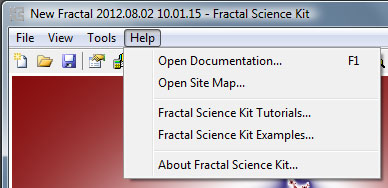
The Help menu has the following commands:
-
Open Documentation... opens the documentation in your browser to this page. See Installing the Documentation for details on downloading a disk-based version of the online documentation to your machine.
-
Open Site Map... opens the documentation in your browser to the Fractal Science Kit Site Map.
-
Fractal Science Kit Tutorials... opens the online tutorials in your browser.
-
Fractal Science Kit Examples... opens the fractal examples page in your browser.
-
About Fractal Science Kit... displays a dialog with product information including the registered user, the product version, and the document version.
